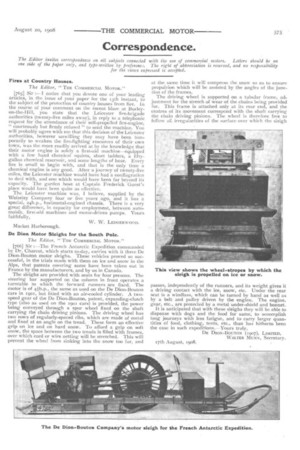Correspondence.
Page 15

If you've noticed an error in this article please click here to report it so we can fix it.
The Editor invites correspondence on all subjects connected with the use of commercial motors. Letters one stele of the paper onl_y, and type-written by preferene:. The right of abbreviation is reserved, and no should be on responsibility for the views expressed is accepted.
Fires at Country Houses.
The Editor, "THE COMMERCIAL MOTOR."
[765] Sir :—I notice that you devote one of your leading articles, in the issue of your paper for the i3th instant, to the subject of the protection of country houses from fire. In the course of your comment on the recent blaze at Burleyon-the-Hill, you state that the Leicester fire-brigade authorities (twenty-five miles away), in reply to a telephonic request for the attendance of their self-propelled fire-engine, " courteously but firmly refused " to send the machine. You will probably agree with me that this decision of the Leicester authorities, however unwilling they may have been temporarily to weaken the fire-fighting resources of their own town, was the more readily arrived at by the knowledge that their motor engine is solely a first-aid machine—equipped with a few hand chemical squirts, short ladders, a fiftygallon chemical reservoir, and some lengths of hose, Every fire is small to begin with, and that is the only time a chemical engine is any good. After a journey of twenty-five miles, the Leicester machine would have had a conflagration to deal with, and one which would have been far beyond its capacity. The garden hose at Captain Frederick Guest's place would have been quite as effective.
The Leicester machine was, I believe, supplied by the Wolseley Company four or five years ago, and it has a special, 24h.p., horizontal-engined chassis. There is a very great difference, in capacity for employment, between automobile, first-aid machines and motor-driven pumps. Yours faithfully, W. W. LEDGEnwoou. Market Harborough.
De Dion Motor Sleighs for the South Pole.
The Editor, " THE COMMERCIAL MOTOR."
[766] Sir :—The French Antarctic Expedition commanded by Dr. Charcot, which starts to-day, carries with it three De Dion-Bouton motor sleighs. These vehicles proved so successful, in the trials made with them on ice and snow in the Alps, that patents covering same have been taken out in France by the manufacturers, and by us in Canada, The sleighs are provided with seats for four persons. The steering bar supported on the column in front operates a turntable to which the forward runners are fixed. The motor is of 40.p., the same as used on the De Dion-Bouton cars in 1901, but fitted with an air-cooled cylinder. A twospeed gear of the De Dion-Bouton, patent, expanding-clutch type (also as used on the toot cars) is provided, the power beiog conveyed through a spur wheel fixed on the shaft carrying the chain driving pinions. The driving wheel has two rows of regularly-spaced ribs, which are made of metal and fixed at an angle on the tread. These form an effective grip on ice and on hard snow. To afford a grip on soft snow, the space between the two treads is filled with frames, over which cord or wire netting will be stretched. This will prevent the wheel from sinking into the snow too far, and
at the same time it will compress the snow so as to ensure propulsion which will be assisted by the angles of the junction of the frames.
The driving wheel is supported on a tubular frame, adjustment for the stretch of wear of the chains being provided for. This frame is attached only at its rear end, and the centres of its movement correspond with the shaft carrying the chain driving pinions. The wheel is therefore free to follow all irregularities of the surface over which the sleigh passes, independently of the runners, and its weight gives it a driving contact with the ice, snow, etc. Under the rear seat is a windlass, which can be turned by hand as well as by a belt and pulley driven by the engine. The engine, gear, etc., are protected by a metal under-shield and bonnet.
It is anticipated that with these sleighs they will be able to dispense with dogs and the food for same, to accomplish long journeys with less fatigue, and to carry larger quantities of food, clothing, tents, etc., than has hitherto been the case in such expeditions.—Yours truly, Dx DION-BOUTON (1907), LIMITED, WALTER MUNN, Secretary. 17th August, 1908.


















